
 The newsletter of NASA's Radio JOVE Project
The newsletter of NASA's Radio JOVE Project"Solar and Planetary Radio Astronomy for Schools"

 The newsletter of NASA's Radio JOVE Project
The newsletter of NASA's Radio JOVE Project

In July and August of 2006 PARI hosted 27 local high school students in our first Space Science Lab (SSL). Radio JOVE kits were their centerpiece project.
The SSL is funded by a three year grant to PARI from the Burroughs-Wellcome Fund Student Science Enrichment Program to encourage under-represented students in math and science. The students were chosen by their teachers as good candidates to participate in this project. Each student received a backpack with the Radio JOVE kit, a soldering iron, and tools. The program was a one week summer school with the students staying on site at PARI.
Their studies began with lectures on astronomy, radio astronomy, solar physics, and basic electronics. Component identification, how to use a digital voltmeter, and soldering was practiced under the watchful eyes of local mentors. Each group of three to four students had one mentor. We started by desoldering random components from old circuit boards, and in some cases resoldering them back into the boards to gain experience using the tools and soldering irons.
The individualized instruction paid off with all twenty-seven students leaving with working JOVE receivers. On the last day we participated in a JOVE teleconference. You should have seen the looks on the students. faces when they realized Dick Flagg and Jim Sky, the creators of the JOVE receiver and SkyPipe software, were right there on the teleconference bridge answering their questions. PARI gave away donated PCs to the students making sure that every student had their own dedicated PC to use for the Radio JOVE project (most of the students did not have computers at home). Many of the donated PCs were Pentium 100s, but have proven perfect for tasks like collecting Radio JOVE data.
PARI will host the students for several Saturday group meetings in coming months to help them maintain momentum in receiving Solar flares and Jupiter. In addition to introducing them to the Radio JOVE list server, we also created their own email group on our server so they could compare notes and work with PARI staff and each other. Thanks to the grant from Burroughs-Wellcome, for the next two summers we anticipate repeating this process with new groups of high school students from surrounding counties. For further information visit PARI.s website http://www.pari.edu and http://www.pari.edu/programs/K12Programs/ssl/ .
PARI is a not-for-profit public foundation located at a former NASA site 30 miles southwest of Asheville, NC. Our mission is to provide research and educational opportunities for a broad cross-section of users in radio and optical astronomy and in the related disciplines of physics, mathematics, engineering, earth sciences, chemistry and computer science.
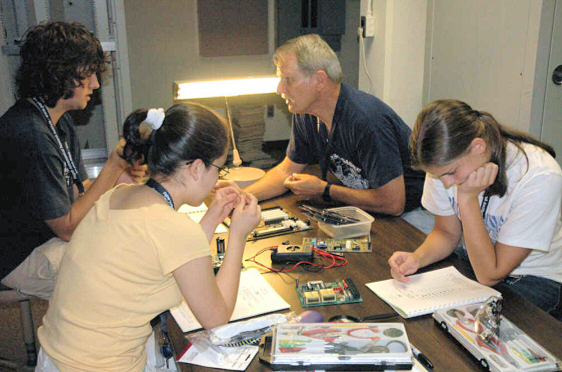
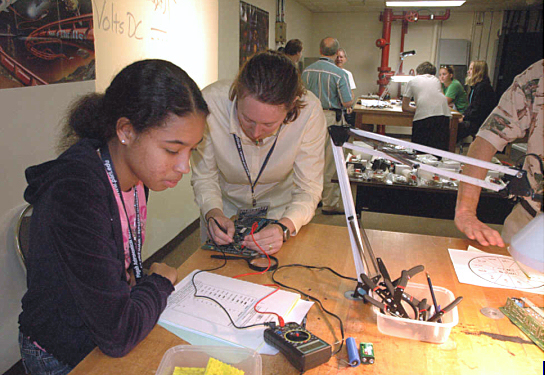
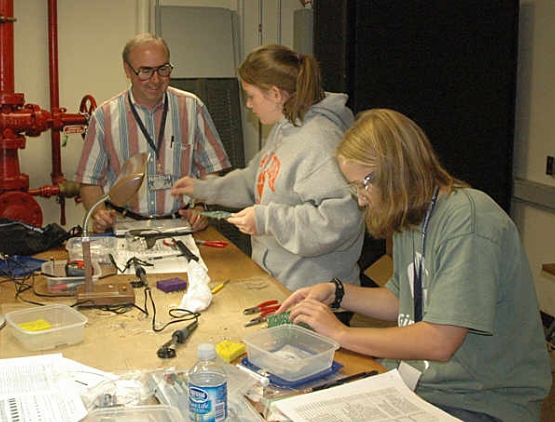
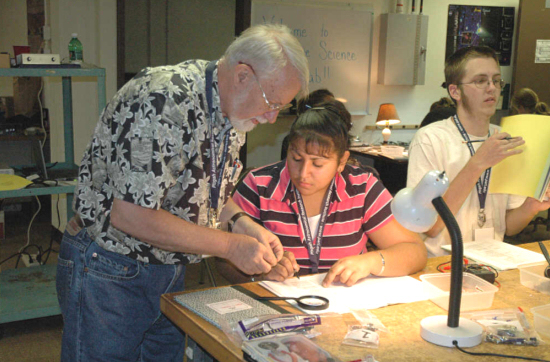
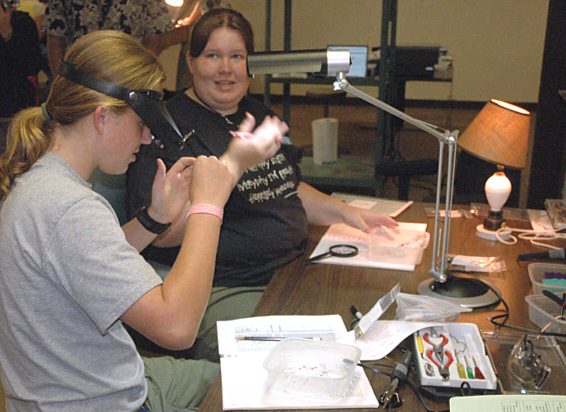

The Warren Rupp Observatory (WRO) is located on the grounds of Friendly House Hidden Hollow Resident Camp near Mansfield, Ohio (USA). The observatory holds monthly public events and hosts numerous educational programs for Hidden Hollow campers, student groups, scouts, and anyone interested in pursuing astronomical outreach - all at no cost. WRO and the Richland Astronomical Society (RAS) also host one of Ohio's premier astronomical conventions, the Hidden Hollow astronomical convention. Once each year, folks from all over the United States gather under some of the darkest skies in Ohio to swap stories and observations. Aside from observing at night, lectures and workshops are held during the day.

The Canal Fulton Amateur Radio Observatory (CFARO) made its second appearance at Hidden Hollow this year. I was again invited by RAS president and observatory director, Tammy Plotner, to lecture on my radio astronomy hobby. At last year's event I made a kiosk of sorts to allow folks to listen to sample radio sounds one might hear at decametric wavelengths. This year the CFARO telescope traveled to Hidden Hollow for a live demonstration! I arrived the day before opening registration and set up a complete Radio JOVE system with one 10' dipole and two computers. Both computers were used to monitor the radio background continuously. Computer one charted the Milky Way over a twenty-four hour period at one sample per second. Skypipe was set to show a 24 hour window from 0000 UT to 2359 UT through which it displayed the local transit of the plane of the Milky Way. During the day, computer two monitored the background for possible solar radio bursts, with a sample rate of 10 samples per second. Having a "live" demonstration like this, open all day and all night, allowed those interested to see the Radio JOVE project firsthand.

Despite less than cooperative weather, this year's convention at Hidden Hollow was a tremendous success. Many thanks to the Radio JOVE project for donating a copy of the project's educational CDs, "Visual Primer to Radio JOVE" and "Radio JOVE Reference", for the door prize drawing. The prize winner, a budding amateur radio astronomer, was thrilled to have won the CDs! (Contributed door prizes are raffled to participants to meet the expenses of having such an event.) I am looking forward to attending future conventions with the complete JOVE telescope. Responses from convention visitors to CFARO and the JOVE project were very positive, a major score in outreach for Radio JOVE. As the sun approaches solar maximum there will be tremendous opportunity to show others just how fascinating the Radio JOVE project truly is. With as much excitement as I have seen over simple lighting strikes, a live demonstration with an active sun or Jupiter could be nothing short of amazing!
A special thanks to Tammy Plotner for her help in preparing this article.
INFORMATION
The Radio JOVE Project: http://radiojove.gsfc.nasa.gov/
The Warren Rupp Observatory: http://www.wro.org/
The Canal Fulton Amateur Radio Observatory: http://members.aol.com/cfaro/index.html
The Astronomy Club of Akron - Akron, OH: http://www.acaoh.org/
The Bluegrass Amateur Astronomy Club - Lexington, KY: http://www.ms.uky.edu/~bgaac/
The Astronomical League: http://www.astroleague.org/
The U.S. Geological Survey: http://www.usgs.gov/
Michael Stephan and the Warsaw Astronomical Society of Indiana have recently been featured in an article published in the South Bend Tribune. The article describes their new Radio Jove system in operation at the Potawotami Wildlife Park.
We heard about this from the Radio Jove email list but we thought this ought to be highlighted more prominently. Below is a part of the email message and a link to a news article from the South Bend Tribune. Thank you Michael. Great work! [Editor.]
"We don't yet know how to interpret our results but hey we at least have a graph going when we hook things up. Our set-up is only temporary while I run permanent runs to my house (closest building) where we will house the receiver and then feed a signal to the Interpretive Center (300' away) for hopefully a public display.
We have a New Moon Group and now a "Radio Astronomy Group" for our small society here in Indiana. We are a core group of maybe half dozen members working our way through the PPTs and trying to learn about radio astronomy."
Read more about it at http://www.southbendtribune.com/apps/pbcs.dll/article?AID=/20061030/News01/610300366/-1/NEWS01.
Michael D. Stephan
Vice President
Warsaw Astronomical Society
Executive Director
Potawatomi Wildlife Park
Indiana's First Dark Sky Preserve
Maunabo is a small town in the south-east corner of the island of Puerto Rico. It is a town bathed by the waters of the Caribbean sea, where the population mainly depends on fishing for their income. Maunabo's Higinio Figueroa Villegas elementary and middle school recently acquired a Radio Jove kit with the assistance of the town's mayor, the Honorable Jorge Marquez, and the Shirohisa Ikeda Project. This kit will enable the students to learn physics, mathematics and astronomy while having fun.
The group of students meets once a week with Mrs. Aida Soto, their science teacher, and Ms. Wanda Diaz from the Shirohisa Ikeda Project to work on subjects related to radio astronomy. These students assembled their first Radio JOVE kit a year ago, while in sixth grade. At that time the soldering took the entire semester. This time the kids used a new technique developed by Wanda Diaz and Leonard Garcia from the Radio JOVE team. This technique was developed to enable the visually impaired to safely solder electrical components. The first kit built with this technique was soldered by Wanda Diaz, Young Lee and Dr. Garcia at NASA/GSFC during the summer of 2006. That receiver is working properly and is being installed in the Cecilia Benitez elementary school in Caguas, PR. The soldering technique was explained to the kids in Maunabo as if they were blind. They were given oral explanations of each component while making use of their visual skills. They were also encouraged to make tactile exploration of the components. The students said they understood better this time. They also thought it was safer and more fun.
The students and the teacher are very enthusiastic!

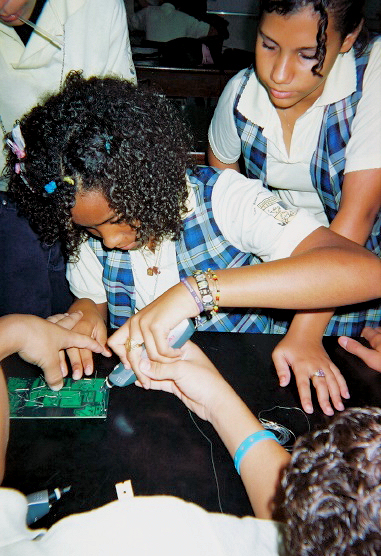
As part of the effort to make Radio JOVE more accessible to everyone, we have been developing non-visual software tools to handle some of the basic functions currently provided by Radio-Jupiter prediction software, Radio-SkyPipe data collection software, and the Spectrograph viewer. These new Windows programs are in the experimental stages but are available for anyone to work with.
These tools do not require the use of a mouse or a monitor. They rely on keyboard inputs to produce the desired functions. This means that the user will have to learn a few commands by reading the appropriate sections of the supplied documentation. There is also some help by pressing F1. Most of the commands are short and intuitive. The output is either spoken in English as in the case of the Radio-Jupiter storm predictions or presented as sonified data. Sonification involves converting the data (such as signal strength) into sound that helps you visualize the signal intensity over time. In the case of the Spectrograph data, a file conversion tool produces a sound spectrum that mimics the RF spectrum over time.
Please feel free to use these programs and provide your comments about them. You can find a page describing the various downloads at: http://radiosky.com/sonification.htm
The Windward Community College Radio Observatory (WCCRO) has moved into the new Lanihuli Observatory building. Eventually the observatory will also house a 16 inch optical telescope to be used for WCC's astronomy courses, students engaged in Hawaii Space Grant Consortium research projects, school groups touring the Aerospace Exploration Lab and the community in general. The observatory also houses a NOAA weather satellite tracking station.
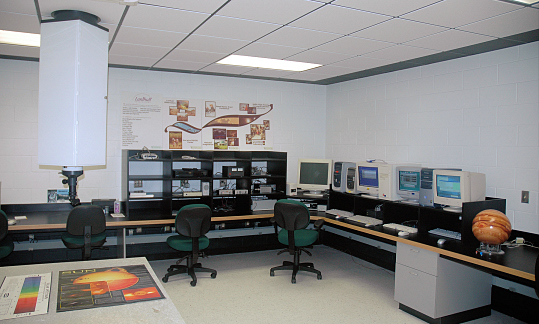
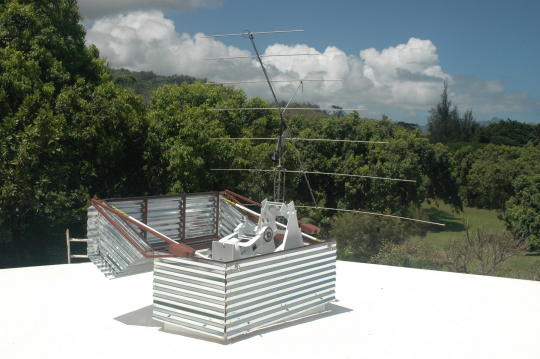
"New Horizons" is a NASA deep-space probe currently en route to fly within 10,000 km of Pluto and its three moons, Charon, Nix, and Hydra. From there, it will continue outward into the Kuiper Belt. Launched in January of this year, the spacecraft was built by John Hopkins Applied Physics Lab and the Southwest Research Institute. It is scheduled to reach Pluto in July 2015.
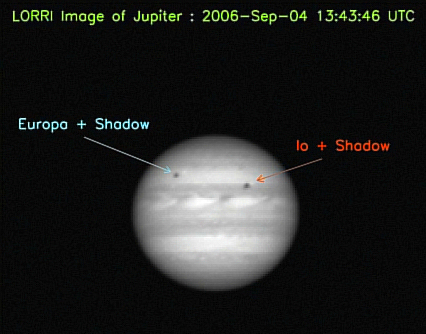
On its way to Pluto, New Horizons will pass within 2.3 million kilometers of Jupiter at 05:41 UTC on February 28, 2007. This planned maneuver will give it a gravity assist. At the point of closest approach to Jupiter, the spacecraft will be traveling at 21 km/s. During this encounter, it will study Jovian atmospheric dynamics, its ring composition, the charged particle composition in Jupiter's magnetotail, lightning, aurorae, and the atmospheres and composition of the Galilean moons. Some limited observations will begin as early as January 1, 2007 with the most intense series of observations being made in a ten day period centered on closest approach. The observations will continue until May or June 2007 as New Horizons becomes the first spacecraft to travel down Jupiter's magnetotail and gathers information on its distant magnetosphere.
The craft has seven scientific instruments. These include the Long Range Reconnaissance Imager telescopic camera (LORRI), the "Ralph" visible/infrared imager/spectrometer, the "Alice" UV imaging spectrometer, the Radio Science Experiment (REX), the Solar Wind around Pluto plasma spectrometer (SWAP), the Pluto Energetic Particle Spectrometer Science Investigation (PEPSSI), the Venetia Burney Student Dust Counter (VBSDC).
Radio Jovers may find REX interesting. This experiment is integrated into the spacecraft's main radio communications system. At Pluto, REX will measure the refraction of the New Horizons' communication signals by Pluto's atmosphere. This will correlate to the average molecular weight and temperature. REX will also be used as a passive radiometer, measuring natural radio emissions in its operating range.
Radio Jove participants may want to make an extra effort to observe Jupiter during the closest approach period and for the few months afterwards. We expect to set up some coordinated observing sessions during this period. Look for announcements on this in emails on the Radio Jove distribution list.
For more information about New Horizons, see http://pluto.jhuapl.edu.
Over the many years that the Radio JOVE project has been in existence we have taken and/or received images of JOVE telescopes in many places around the world. See last issue for Radio JOVE dipoles in Australia, Montana and Japan. Below are shown some more of the archive of photos that we have built. Perhaps you would like to contribute to a follow-on to this article as well. It would be good, of course, if there were something unique about the photo, such as a unique approach to how the antenna is supported, a unique type of antenns, a unique setting in which it appears, or maybe just the unique person or persons associated with that antenna. Please be sure that we have permission to show the pictures of individuals if they are identifiable in the picture. Thanks for any submissions.





On behalf of all of the folks who volunteer their time and talents to the Radio JOVE Project, I would like to announce the creation of The Radio JOVE Project, Inc. This is a not-for-profit company created in August 2006 that will specialize in radio science education products and mainly serve as the distributor for the Radio JOVE telescope kits. The primary purpose for starting this company is to be able to more easily handle the RJ kit parts ordering and financial aspects of kit improvement and distribution. Another nice benefit is that we can now accept donations from folks who are interested in radio astronomy and education. Therefore, let me make the first solicitation: If you or anyone you know (individual or company) would like to make a tax-deductible contribution to the Radio JOVE Project, Inc. please inquire at the address below. Thank you very much.
The Radio JOVE Project, Inc.
MTSU Box 412
1301 E. Main St.
Murfreesboro, TN 37132
FEIN: 20-5239863
E-mail: chiggins@mtsu.edu
The JOVE Bulletin is published twice a year. It is a free service of the Radio JOVE Project. We hope you will find it of value. Back issues are available on the Radio JOVE Project Web site, http://radiojove.gsfc.nasa.gov/
For assistance or information send inquiries to:
or
